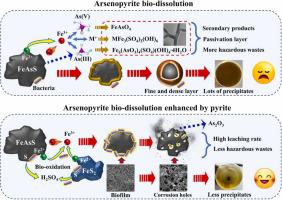当前位置:
X-MOL 学术
›
J. Hazard. Mater.
›
论文详情
Our official English website, www.x-mol.net, welcomes your feedback! (Note: you will need to create a separate account there.)
Novel insights into the kinetics and mechanism of arsenopyrite bio-dissolution enhanced by pyrite
Journal of Hazardous Materials ( IF 13.6 ) Pub Date : 2024-04-02 , DOI: 10.1016/j.jhazmat.2024.134193 Duo-Rui Zhang , Rui-Yong Zhang , Xue-Tai Zhu , Wei-Bao Kong , Chun Cao , Lei Zheng , Eva Pakostova
Journal of Hazardous Materials ( IF 13.6 ) Pub Date : 2024-04-02 , DOI: 10.1016/j.jhazmat.2024.134193 Duo-Rui Zhang , Rui-Yong Zhang , Xue-Tai Zhu , Wei-Bao Kong , Chun Cao , Lei Zheng , Eva Pakostova

|
Arsenopyrite and pyrite often coexist in metal deposits and tailings, thus simultaneous bioleaching of both sulfides has economic (as well as environmental) significance. Important targets in bio-oxidation operations are high solubilization rates and minimized accumulation of Fe(III)/As-bearing secondary products. This study investigated the role of pyrite bioleaching in the enhancement of arsenopyrite dissolution. At a pyrite to arsenopyrite mass ratio of 1:1, 93.6% of As and 93.0% of Fe were solubilized. The results show that pyrite bio-oxidation can promote arsenopyrite dissolution, enhance S bio-oxidation, and inhibit the formation of jarosites, tooeleite, and amorphous ferric arsenate. The dry weight of the pyrite & arsenopyrite residue was reduced by 95.1% after bioleaching, compared to the initial load, while only 5% weight loss was observed when pyrite was absent. A biofilm was formed on the arsenopyrite surface in the presence of pyrite, while a dense passivation layer was observed in the absence of pyrite. As(III) (as AsO) was a dominant As species in the pyrite & arsenopyrite residue. Novel and detailed findings are presented on arsenopyrite bio-dissolution in the presence of pyrite, and the presented approach could contribute to the development of novel cost-effective extractive bioprocesses. The oxidation of arsenopyrite presents significant environmental hazards, as it can contribute to acid mine drainage generation and arsenic mobilization from sulfidic mine wastes. Bioleaching is a proven cost-effective and environmentally friendly extractive technology, which has been applied for decades in metal recovery from minerals or tailings. In this work, efficient extraction of arsenic from arsenopyrite bioleaching was presented through coupling the process with bio-oxidation of pyrite, resulting in lowered accumulation of hazardous and metastable Fe(III)/As-bearing secondary phases. The results could help improve current biomining operations and/or contribute to the development of novel cost-effective bioprocesses for metal extraction.
中文翻译:

对黄铁矿增强毒砂生物溶解动力学和机制的新见解
毒砂和黄铁矿经常共存于金属矿床和尾矿中,因此两种硫化物的同时生物浸出具有经济(以及环境)意义。生物氧化操作的重要目标是高溶解率和最大限度地减少含 Fe(III)/As 的二次产物的积累。本研究研究了黄铁矿生物浸出在增强毒砂溶解中的作用。当黄铁矿与毒砂质量比为1:1时,固溶了93.6%的As和93.0%的Fe。结果表明,黄铁矿生物氧化可以促进毒砂溶解,增强硫的生物氧化,抑制黄钾铁矾、霞铁矿和无定形砷酸铁的形成。与初始负载相比,生物浸出后黄铁矿和毒砂残渣的干重减少了 95.1%,而当不存在黄铁矿时,仅观察到 5% 的重量损失。当黄铁矿存在时,毒砂表面形成生物膜,而当黄铁矿不存在时,则观察到致密的钝化层。 As(III)(以 AsO 计)是黄铁矿和毒砂残渣中的主要 As 形态。提出了关于黄铁矿存在下毒砂生物溶解的新颖而详细的发现,所提出的方法可能有助于开发新型的具有成本效益的提取生物工艺。毒砂的氧化会造成严重的环境危害,因为它会导致酸性矿山排水的产生和硫化矿山废物中砷的动员。生物浸出是一种经过验证的经济高效且环保的提取技术,数十年来一直应用于从矿物或尾矿中回收金属。在这项工作中,通过将毒砂生物浸出过程与黄铁矿生物氧化耦合,提出了从毒砂生物浸出中有效提取砷的方法,从而减少了有害且亚稳态的含 Fe(III)/As 二次相的积累。研究结果可能有助于改善当前的生物采矿作业和/或有助于开发新颖的具有成本效益的金属提取生物工艺。
更新日期:2024-04-02
中文翻译:

对黄铁矿增强毒砂生物溶解动力学和机制的新见解
毒砂和黄铁矿经常共存于金属矿床和尾矿中,因此两种硫化物的同时生物浸出具有经济(以及环境)意义。生物氧化操作的重要目标是高溶解率和最大限度地减少含 Fe(III)/As 的二次产物的积累。本研究研究了黄铁矿生物浸出在增强毒砂溶解中的作用。当黄铁矿与毒砂质量比为1:1时,固溶了93.6%的As和93.0%的Fe。结果表明,黄铁矿生物氧化可以促进毒砂溶解,增强硫的生物氧化,抑制黄钾铁矾、霞铁矿和无定形砷酸铁的形成。与初始负载相比,生物浸出后黄铁矿和毒砂残渣的干重减少了 95.1%,而当不存在黄铁矿时,仅观察到 5% 的重量损失。当黄铁矿存在时,毒砂表面形成生物膜,而当黄铁矿不存在时,则观察到致密的钝化层。 As(III)(以 AsO 计)是黄铁矿和毒砂残渣中的主要 As 形态。提出了关于黄铁矿存在下毒砂生物溶解的新颖而详细的发现,所提出的方法可能有助于开发新型的具有成本效益的提取生物工艺。毒砂的氧化会造成严重的环境危害,因为它会导致酸性矿山排水的产生和硫化矿山废物中砷的动员。生物浸出是一种经过验证的经济高效且环保的提取技术,数十年来一直应用于从矿物或尾矿中回收金属。在这项工作中,通过将毒砂生物浸出过程与黄铁矿生物氧化耦合,提出了从毒砂生物浸出中有效提取砷的方法,从而减少了有害且亚稳态的含 Fe(III)/As 二次相的积累。研究结果可能有助于改善当前的生物采矿作业和/或有助于开发新颖的具有成本效益的金属提取生物工艺。



























 京公网安备 11010802027423号
京公网安备 11010802027423号